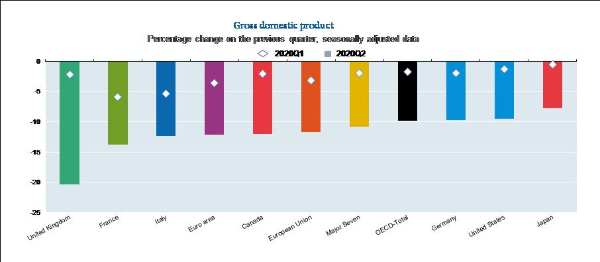Unprecedented Fall In OECD GDP By 9.8% In Q2 2020
Following the introduction of COVID-19 containment measures across the world since March 2020, real gross domestic product (GDP) in the OECD area showed an unprecedented fall, by (minus) 9.8%, in the second quarter of 2020, according to provisional estimates. This is the largest drop ever recorded for the OECD area, significantly larger than the (minus) 2.3% recorded in the first quarter of 2009, at the height of the financial crisis.
Among the Major Seven economies, GDP fell most dramatically, by (minus) 20.4%, in the United Kingdom. In France, where lockdown measures were among the most stringent, GDP declined by (minus) 13.8%, after a drop of (minus) 5.9% in the previous quarter.
GDP also fell sharply in Italy, Canada and Germany in the second quarter (by (minus) 12.4%, (minus) 12.0% and (minus) 9.7% respectively (compared with (minus) 5.4%, (minus) 2.1% and (minus) 2.0% in the previous quarter).
In the United States, where many states introduced ‘stay-at-home’ measures late March, GDP contracted slightly less ((minus) 9.5%, compared with (minus) 1.3% in the previous quarter).
In Japan, where containment measures were less stringent, GDP contracted by (minus) 7.8% in the second quarter of 2020, compared with (minus) 0.6% in the previous quarter.
In the euro area and the European Union, GDP dropped by (minus) 12.1% and (minus) 11.7% respectively, compared with declines of (minus) 3.6% and (minus) 3.2% in the previous quarter.
Year-on-year GDP growth for the OECD area was minus 10.9% in the second quarter of 2020, following growth of minus 0.9% in the previous quarter. Among the Major Seven economies, the United States recorded an annual growth of minus 9.5%, while the United Kingdom recorded the sharpest annual fall (minus 21.7%).
Read the full release

Visit the interactive OECD Data Portal to explore this data further
Note: As a consequence of measures put in place by governments to reduce the spread of the Coronavirus (COVID-19), many statistical agencies are facing unprecedented collection, compilation and methodological challenges to develop indicators across a number of domains. To address these challenges, the statistical community is developing guidance, both conceptual and practical, to help ensure the continued delivery of timely and reliable statistics. However, in some cases, there will inevitably be an impact on quality and, as such, the statistics included in this press release may be subject to larger, and more frequent, than normal revisions.


 CNS: Will All Children Be Born Free Of HIV, Syphilis And Hepatitis-B By 2030?
CNS: Will All Children Be Born Free Of HIV, Syphilis And Hepatitis-B By 2030? Save The Children: Sudan - One Child Every 10 Seconds Forced To Flee Their Home Since Conflict Began Two Years Ago
Save The Children: Sudan - One Child Every 10 Seconds Forced To Flee Their Home Since Conflict Began Two Years Ago People with Disability Australia - PWDA: People With Disability Invisible In Election Debates And Housing Promises
People with Disability Australia - PWDA: People With Disability Invisible In Election Debates And Housing Promises East West Center: NZ Deputy Prime Minister Recounts Longstanding US-NZ Relationship In The Pacific
East West Center: NZ Deputy Prime Minister Recounts Longstanding US-NZ Relationship In The Pacific Global Jews for Palestine: Jewish Organisations' Passover Statement, After 40 Days Of Starvation
Global Jews for Palestine: Jewish Organisations' Passover Statement, After 40 Days Of Starvation APEC: Stronger Immunization Policies Needed As Vaccine Confidence Falls
APEC: Stronger Immunization Policies Needed As Vaccine Confidence Falls